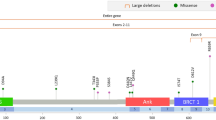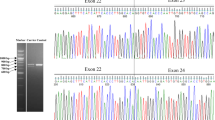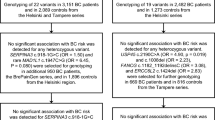Abstract
We sequenced approximately 23 kb genomic regions containing all the coding exons and their franking introns of two breast cancer susceptibility genes, BRCA1 and BRCA2, of 55 individuals from 50 unrelated Japanese breast cancer families. We identified 55 single-nucleotide polymorphisms (SNPs) (21 in BRCA1 and 34 in BRCA2) containing nine pathogenic protein-truncating mutations (four in BRCA1 and five in BRCA2 from ten patients). Among the remaining 46 SNPs, allele frequencies of 40 were examined in both the breast cancer patients and 28 healthy volunteers with no breast cancer family history by PCR-RFLP or by direct DNA sequencing. Twenty-eight SNPs were common and were also found in the healthy volunteers and/or a SNP database. The remaining 18 were rare (allele frequency <0.05) and were not found in the healthy volunteers and/or the database. The pathogenic significance of these coding SNPs (cSNPs) remains to be clarified. The SNP information from this study will be useful in the future genetic testing of both BRCA1 and BRCA2 genes in the Japanese population.
Similar content being viewed by others
Introduction
Mutations in the BRCA1 and the BRCA2 genes have been linked with the susceptibility to breast and ovarian cancer (Miki et al. 1994; Wooster et al. 1995; Tavtigian et al. 1996). Mutation carriers of these genes are at high risk of breast and ovarian cancer (Narod et al. 1995; Ford et al. 1998; Thorlacius et al. 1998; Neuhausen 1999; Rebbeck 1999; Struewing et al. 1997; Anglian Breast Cancer Study Group 2000). The two genes have large coding sequences consisting of 48 exons in total, and a large number of mutations and SNPs are reported in the Breast Cancer Information Core (BIC) database (http://research.nhgri.nih.gov/bic/) and the dbSNP database (http://www.ncbi.nlm.nih.gov/SNP/index.html). The majority of mutations described are protein-truncating mutations containing frame-shift mutations and nonsense mutations. In the BIC database, 55.9% of genetic variants are reported as pathogenic mutations containing mainly protein-truncating mutations and a small fraction of pathogenic missense mutations, and 39.3% of variants are categorized as “unclassified variants.” These variants contain coding SNPs (cSNPs) that result in amino-acid substitutions or SNPs located at exon–intron boundaries. We have also reported five protein-truncating mutations and 12 “unclassified variants” that have been found only once in 24 breast cancer families (Sakayori et al. 2003). To elucidate whether detected SNPs are pathogenic mutations or not, it is important to accumulate SNP information (both the type and allele frequency) in patients and the general population.
In this study, we extended our study on the BRCA1 and BRCA2 sequencing project to 55 breast cancer patients from 50 Japanese breast cancer families. We evaluated the detected SNPs by comparing the allele frequency of the SNPs in healthy volunteers.
Subjects and methods
Fifty-five enrolled patients (including 50 probands and five relatives) with a history of breast cancer from 50 unrelated high-risk breast cancer families were selected according to the criteria defined by the Tohoku Familial Cancer Society (Sakayori et al. 2003). An additional 28 Japanese volunteers with no breast cancer family history were also enrolled to analyze the specific BRCA1 and BRCA2 variations detected in the breast cancer patients. We obtained informed consent from all patients and volunteers, and the independent studies were approved by the Familial Cancer Society and the Ethical Committee of Tohoku University Graduate School of Medicine. To identify the sequence variations in the BRCA1 and BRCA2 genes of the familial breast cancer patients, we sequenced approximately 23 kb genomic regions of the BRCA1 (8.4 kb) and the BRCA2 (14.6 kb) containing all coding exons and their franking introns using a method described previously (Sakayori et al. 2003). The identified SNPs found in the familial breast cancer patients were also examined in the genomic DNA from the healthy volunteers by PCR-RFLP analysis using PCR primers, cycle conditions and restriction enzymes for PCR-RFLP analysis (http://www.idac.tohoku.ac.jp/dep/co/data/saka/brca02.htm) or by DNA sequence analysis. We used Genbank (U14680 and U61268 for BRCA1, U43746 and X95152-77 for BRCA2) and the BIC database as the reference sequences of BRCA1 and BRCA2 genes.
Results and discussion
By DNA sequencing analysis of the BRCA1 and BRCA2 genes for 55 patients from 50 unrelated breast cancer families; we detected 55 SNPs (21 SNPs in BRCA1 and 34 SNPs in BRCA2). Among these SNPs, we found nine protein-truncating mutations (four in BRCA1 and five in BRCA2) in ten patients containing six novel mutations that were not found in the BIC database (http://research.nhgri.nih.gov/bic/) (Table 1). The existence of mutations were also confirmed by the stop codon assay in yeast (Ishioka et al. 1997; Sakayori et al. 2003). The percentage of protein-truncating mutations in the examined families was 20% (ten of 50), comparable with several reports describing the frequency of protein-truncating mutations of the two genes in Japanese breast cancer families (Inoue et al. 1995; Takano et al. 1997; Inoue et al. 1997; Ikeda et al. 2001). Although the frequency was also similar to results from Western populations, the number of patients studied in our and other Japanese populations was smaller than that in Western countries. Therefore, it is necessary to study a larger number of patients to clarify the mutation frequency in Japanese familial breast cancer.
Among the remaining 46 SNPs (17 SNPs in BRCA1 and 29 SNPs in BRCA2), 18 and 31 have been reported in the dbSNP database and in the BIC database, respectively, (Table 1). To evaluate whether the SNPs are also found in Japanese healthy volunteers, all but six SNPs were further examined by PCR-RFLP analysis or by DNA sequence analysis. Twenty-six SNPs were found in the volunteers at least once with different allele frequencies (Table 2). In these 40 SNPs, we predicted that 27 SNPs were common polymorphisms and probably played no direct role in the tumorigenesis of breast cancer. The remaining 13 SNPs were quite low in allele frequency (<0.05) and were not found in the healthy volunteers or the dbSNP database. In addition, there were six SNPs that failed to examine in the volunteer group. In these six SNPs, one was predicted to be common and five to be rare from the allele frequencies in the patients. Overall, we predicted the 18 rare SNPs are candidates of pathogenic mutations and that the remaining 28 were common polymorphisms and probably have no direct roll in tumorigenesis of breast cancer. In the 18 rare SNPs, five (BRCA1-13, BRCA1-17, BRCA1-18, BRCA2-2, BRCA2-3) were located at the exon–intron boundaries and two (BRCA2-23, BRCA2-27) were located in introns far from exon–intron boundaries. Although SNPs at the exon–intron boundaries may affect normal RNA splicing, our RT-PCR analysis showed negative data for splicing abnormalities. In the remaining 11 rare cSNPs, seven (BRCA1-4, BRCA1-20, BRCA2-12, BRCA2-19, BRCA2-25, BRCA2-30 and BRCA2-34) were nonsynonymous substitution resulting in the amino-acid substitutions, and four (BRCA2-8, BRCA2-17, BRCA2-31 and BRCA2-33) were synonymous (silent) changes. These SNPs may directly affect the functions of BRCA1 and BRCA2 proteins or affect normal splicing by acting as possible cryptic splicing sites. Unfortunately, we have failed to clarify this issue mainly because there are no reliable functional assays of either BRCA1 or BRCA2 protein for many nonsynonymous changes.
To confirm the pathogenic effect of rare SNPs, both the development of functional assays for these gene products and more intensive SNP analysis including an investigation into whether these SNPs cosegregate with breast cancer onset in families are necessary.
References
Anglian Breast Cancer Study Group (2000) Prevalence and penetrance of BRCA1 and BRCA2 mutations in a population-based series of breast cancer cases. Br J Cancer 83:1301–1308
Ford D, Easton DF, Stratton M, Narod S, Goldgar D, Devilee P, Bishop DT, Weber B, Lenoir G, Chang-Claude J, Sobol H, Teare MD, Struewing J, Arason A, Scherneck S, Peto J, Rebbeck TR, Tonin P, Neuhausen S, Barkardottir R, Eyfjord J, Lynch H, Ponder BA, Gayther SA, Zelada-Hedman M et al (1998) Genetic heterogeneity and penetrance analysis of the BRCA1 and BRCA2 genes in breast cancer families. The breast cancer linkage consortium. Am J Hum Genet 62:676–689
Ikeda N, Miyoshi Y, Yoneda K, Shiba E, Sekihara Y, Kinoshita M, Noguchi S (2001) Frequency of BRCA1 and BRCA2 germline mutations in Japanese breast cancer families. Int J Cancer 91:83–88
Inoue R, Fukutomi T, Ushijima T, Matsumoto Y, Sugimura T, Nagao M (1995) Germline mutation of BRCA1 in Japanese breast cancer families. Cancer Res 55:3521–3524
Inoue R, Ushijima T, Fukutomi T, Fukami A, Sugimura H, Inoue S, Okonogi H, Sugimura T, Matsumoto Y, Nagao M (1997) BRCA2 germline mutations in Japanese breast cancer families. Int J Cancer 74:199–204
Ishioka C, Suzuki T, FitzGerald M, Krainer M, Shimodaira H, Shimada A, Nomizu T, Isselbacher KJ, Haber D, Kanamaru R (1997) Detection of heterozygous truncating mutations in the BRCA1 and APC genes by using a rapid screening assay in yeast. Proc Natl Acad Sci USA 94:2449–2453
Miki Y, Swensen J, Shattuck-Eidens D, Futreal PA, Harshman K, Tavtigian S, Liu Q, Cochran C, Bennett LM, Ding W and others (1994) A strong candidate for the breast and ovarian cancer susceptibility gene BRCA1. Science 266:66–71
Narod SA, Ford D, Devilee P, Barkardottir RB, Lynch HT, Smith SA, Ponder BA, Weber BL, Garber JE, Birch JM and others (1995) An evaluation of genetic heterogeneity in 145 breast-ovarian cancer families. Breast cancer linkage consortium. Am J Hum Genet 56:254–264
Neuhausen SL (1999) Ethnic differences in cancer risk resulting from genetic variation. Cancer 86:2575–2582
Rebbeck TR (1999) Inherited genetic predisposition in breast cancer. A population-based perspective. Cancer 86:2493–2501
Sakayori M, Kawahara M, Shiraishi K, Nomizu T, Shimada A, Kudo T, Abe R, Ohuchi N, Takenoshita S, Kanamaru R, Ishioka C (2003) Evaluation of the diagnostic accuracy of the stop codon (SC) assay for identifying protein-truncating mutations in the BRCA1 and BRCA2 genes in familial breast cancer. J Hum Genet 48:130–137
Struewing JP, Hartge P, Wacholder S, Baker SM, Berlin M, McAdams M, Timmerman MM, Brody LC, Tucker MA (1997) The risk of cancer associated with specific mutations of BRCA1 and BRCA2 among Ashkenazi Jews. N Engl J Med 336:1401–1408
Takano M, Aida H, Tsuneki I, Takakuwa K, Hasegawa I, Tanaka H, Saito M, Tsuji S, Sonoda T, Hatae M, Chen JT, Takahashi K, Hasegawa K, Toyoda N, Saito N, Yakushiji M, Araki T, Tanaka K (1997) Mutational analysis of BRCA1 gene in ovarian and breast-ovarian cancer families in Japan. Jpn J Cancer Res 88:407–413
Tavtigian SV, Simard J, Rommens J, Couch F, Shattuck-Eidens D, Neuhausen S, Merajver S, Thorlacius S, Offit K, Stoppa-Lyonnet D, Belanger C, Bell R, Berry S, Bogden R, Chen Q, Davis T, Dumont M, Frye C, Hattier T, Jammulapati S, Janecki T, Jiang P, Kehrer R, Leblanc JF, Goldgar DE et al (1996) The complete BRCA2 gene and mutations in chromosome 13q-linked kindreds. Nat Genet 12:333–337
Thorlacius S, Struewing JP, Hartge P, Olafsdottir GH, Sigvaldason H, Tryggvadottir L, Wacholder S, Tulinius H, Eyfjord JE (1998) Population-based study of risk of breast cancer in carriers of BRCA2 mutation. Lancet 352:1337–1339
Wooster R, Bignell G, Lancaster J, Swift S, Seal S, Mangion J, Collins N, Gregory S, Gumbs C, Micklem G (1995) Identification of the breast cancer susceptibility gene BRCA2. Nature 378:789–792
Acknowledgements
We thank patients and their families for participating in this study. We also thank Yuka Fujimaki for technical assistance. This study was supported in part by a grant from the Ministry of Education, Science, Sports and Culture of Japan.
Author information
Authors and Affiliations
Corresponding author
Additional information
The first two authors contributed equally to this study.
Rights and permissions
About this article
Cite this article
Kawahara, M., Sakayori, M., Shiraishi, K. et al. Identification and evaluation of 55 genetic variations in the BRCA1 and the BRCA2 genes of patients from 50 Japanese breast cancer families. J Hum Genet 49, 391–395 (2004). https://doi.org/10.1007/s10038-004-0160-5
Received:
Accepted:
Published:
Issue Date:
DOI: https://doi.org/10.1007/s10038-004-0160-5
Keywords
This article is cited by
-
Analysis of p.Gly12Valfs*2, p.Trp24* and p.Trp77Arg mutations in GJB2 and p.Arg81Gln variant in LRTOMT among non syndromic hearing loss Egyptian patients: implications for genetic diagnosis
Molecular Biology Reports (2019)
-
Three cases of kindred with familial breast cancer in which carrier detection by BRCA gene testing was performed on family members
Breast Cancer (2012)
-
Results of a population-based screening for hereditary breast cancer in a region of North-Central Italy: contribution of BRCA1/2 germ-line mutations
Breast Cancer Research and Treatment (2008)



